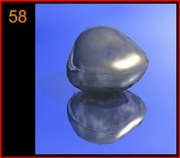Difference between revisions of "Cerium"
Jump to navigation
Jump to search
(username removed) |
|||
| (2 intermediate revisions by 2 users not shown) | |||
| Line 2: | Line 2: | ||
== Description == | == Description == | ||
| − | A rare earth element. Cerium has an abundance in the earth's crust of 46 ppm. It is found in the minerals cerite, bastnasite, and monazite. It was discovered in 1803 by Baron Berzelius, a Swedish chemist. Cerium is a gray ductile metal that is very reactive. It is used in metal alloys to increase creep resistance, and add strength. It also serves as a getter to remove traces of oxygen. [ | + | A rare earth element. Cerium has an abundance in the earth's crust of 46 ppm. It is found in the minerals cerite, bastnasite, and monazite. It was discovered in 1803 by Baron Berzelius, a Swedish chemist. Cerium is a gray ductile metal that is very reactive. It is used in metal alloys to increase creep resistance, and add strength. It also serves as a getter to remove traces of oxygen. [[Ceric oxide]] is used as an abrasive, catalyst, and as an ingredient in glass and glazes. |
== Synonyms and Related Terms == | == Synonyms and Related Terms == | ||
| Line 8: | Line 8: | ||
Ce | Ce | ||
| − | == | + | == Risks == |
| + | |||
| + | * Powder may ignite spontaneously. | ||
| + | * Fisher Scientific: [https://fscimage.fishersci.com/msds/99074.htm MSDS] | ||
| + | |||
| + | ==Physical and Chemical Properties== | ||
Attacked by mineral acids and alkalis. Oxidizes in moist air. | Attacked by mineral acids and alkalis. Oxidizes in moist air. | ||
| Line 21: | Line 26: | ||
|- | |- | ||
! scope="row"| Melting Point | ! scope="row"| Melting Point | ||
| − | | 798 | + | | 798 C |
|- | |- | ||
! scope="row"| Density | ! scope="row"| Density | ||
| − | | 6.770 | + | | 6.770 g/ml |
|- | |- | ||
! scope="row"| Molecular Weight | ! scope="row"| Molecular Weight | ||
| Line 30: | Line 35: | ||
|- | |- | ||
! scope="row"| Boiling Point | ! scope="row"| Boiling Point | ||
| − | | 3433 | + | | 3433 C |
|} | |} | ||
| − | == | + | ==Resources and Citations== |
| − | |||
| − | |||
| − | |||
| − | |||
| − | |||
| − | |||
* ''Van Nostrand's Scientific Encyclopedia'', Douglas M. Considine (ed.), Van Nostrand Reinhold, New York, 1976 | * ''Van Nostrand's Scientific Encyclopedia'', Douglas M. Considine (ed.), Van Nostrand Reinhold, New York, 1976 | ||
Latest revision as of 09:35, 24 May 2022
Description
A rare earth element. Cerium has an abundance in the earth's crust of 46 ppm. It is found in the minerals cerite, bastnasite, and monazite. It was discovered in 1803 by Baron Berzelius, a Swedish chemist. Cerium is a gray ductile metal that is very reactive. It is used in metal alloys to increase creep resistance, and add strength. It also serves as a getter to remove traces of oxygen. Ceric oxide is used as an abrasive, catalyst, and as an ingredient in glass and glazes.
Synonyms and Related Terms
Ce
Risks
- Powder may ignite spontaneously.
- Fisher Scientific: MSDS
Physical and Chemical Properties
Attacked by mineral acids and alkalis. Oxidizes in moist air.
| Composition | Ce (atomic no. 58) |
|---|---|
| CAS | 7440-45-1 |
| Melting Point | 798 C |
| Density | 6.770 g/ml |
| Molecular Weight | atomic wt. = 140.115 |
| Boiling Point | 3433 C |
Resources and Citations
- Van Nostrand's Scientific Encyclopedia, Douglas M. Considine (ed.), Van Nostrand Reinhold, New York, 1976
- Random House, Webster's Encyclopedic Unabridged Dictionary of the English Language, Grammercy Book, New York, 1997
- The Merck Index, Martha Windholz (ed.), Merck Research Labs, Rahway NJ, 10th edition, 1983 Comment: entry 2037
- The American Heritage Dictionary or Encarta, via Microsoft Bookshelf 98, Microsoft Corp., 1998
